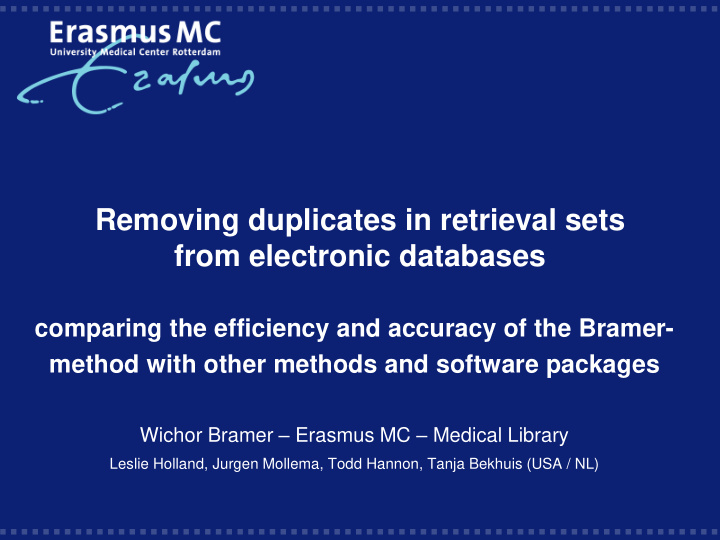



Removing duplicates in retrieval sets from electronic databases comparing the efficiency and accuracy of the Bramer- method with other methods and software packages Wichor Bramer – Erasmus MC – Medical Library Leslie Holland, Jurgen Mollema, Todd Hannon, Tanja Bekhuis (USA / NL)
What are duplicate referencess? Referering to the same bibliographic entity Unique identifiers? DOI / PMID Not always present in database or in export files Limited use in software Equal author, title, journal, volume, issue, pages Data can vary between databases or in time
Removing duplicates is important (median 43%) 90 80 80 74 70 60 63 Number of SRs 50 40 36 35 30 24 20 18 10 9 1 5 2 0 10% 15% 20% 25% 30% 35% 40% 45% 50% 55% 60% 65% 70% percentage of duplicates among search results
Removing duplicates is cumbersome Do you deduplicate for your patrons? some- always never times 0% 50% 100% … Does not use default settings because of abbreviated and long forms of journal names. … Several iterations with different settings. Ends with manual scan. … Manually checks author names and page numbers to de-dupe. … Manually de-dupes in reverse chronological order.
Removing duplicates is problematic “Missed duplicates despite best efforts” “Authors who publish similar titles at various conferences” “Having to manually eyeball exact matches” “De -duping can take forever ” Removing duplicates is time consuming Number of references Average time needed 500 30 minutes 2000 1.5 hours 10000 6 hours Sources: non-published questionnaires by Bekhuis, and by Bramer
Challenges for deduplication methods Reduce the number of hits substantially Without deleting false duplicates Not not any or too much? Without taking hours to perform
Methods for deduplication Software programs Endnote Reference Manager Refworks Papers Mendeley Zotero Jabref Paperpile and? Published algorithms Qi, Yang et al, 2013 – PLoS One Jiang, Lin et al, 2014 – Database Own algorithm Bramer method
Methods Three gold standard sets Around 1000 records each 4 databases (embase.com, medline OvidSP, Web-of-Science, Scopus) Deduplicated manually (author sorted, title sorted, manual comparison) Golden standard sets deduplicated using the standard methods of the software recording effort (time and clicks) Results compared to hand deduplicated results # of records en # false duplicates For now by one person, but plans are to repeat the experiments
Results of comparison
The Bramer method is fast 20 Time needed for deduplication (min) 15 In the hands of its developer 10 5 0 0 5 10 15 Number of results (x 1000)
Is the Bramer method accurate? 0,03% Golden standard: 1 error in 3423 records 2 errors in 22339 records 0,01% Qi reference set: Jiang reference set: 14 errors in 6265 records 0,22% Two equal conference proceedings 4 Updated Cochrane review 4 Conference proceedings kept full text dropped 4 Truly false duplicates removed 2 10? 0,16% 6? 0,10% 2? 0,03%
Discussion What is a problematic false duplicate Librarians Researchers (what is a valueable bibliographic entity) (N=7) (N=27) 71% 7% Conf – Conf 57% 2% Full – Conf 86% 93% Conf – Full 29% When you consider that for relevant conference papers you try to find the published article 64% 20% Version 2 – Version 1
Discussion Is it problematic to falsely delete 0.2% unique references? With on average 2-3% of the results included 0.2% deduplication errors means 0.5 include missed in 10,000 references (How sure are you that the search did not miss any relevant articles)
Limitations of the Bramer method Bound to EndNote software package Data restructuring helpfull (required for speed) : embase, WoS, Scopus: abbreviated journal titles medline / cochrane: full page numbers Possibly rather steep learning curve
Ongoing research You are invited to use the Bramer method for your own deduplication process Please share your experiences about its speed and accuracy We will continue comparing other (new) methods And replicate the experiments already performed by the first author
Recommend
More recommend